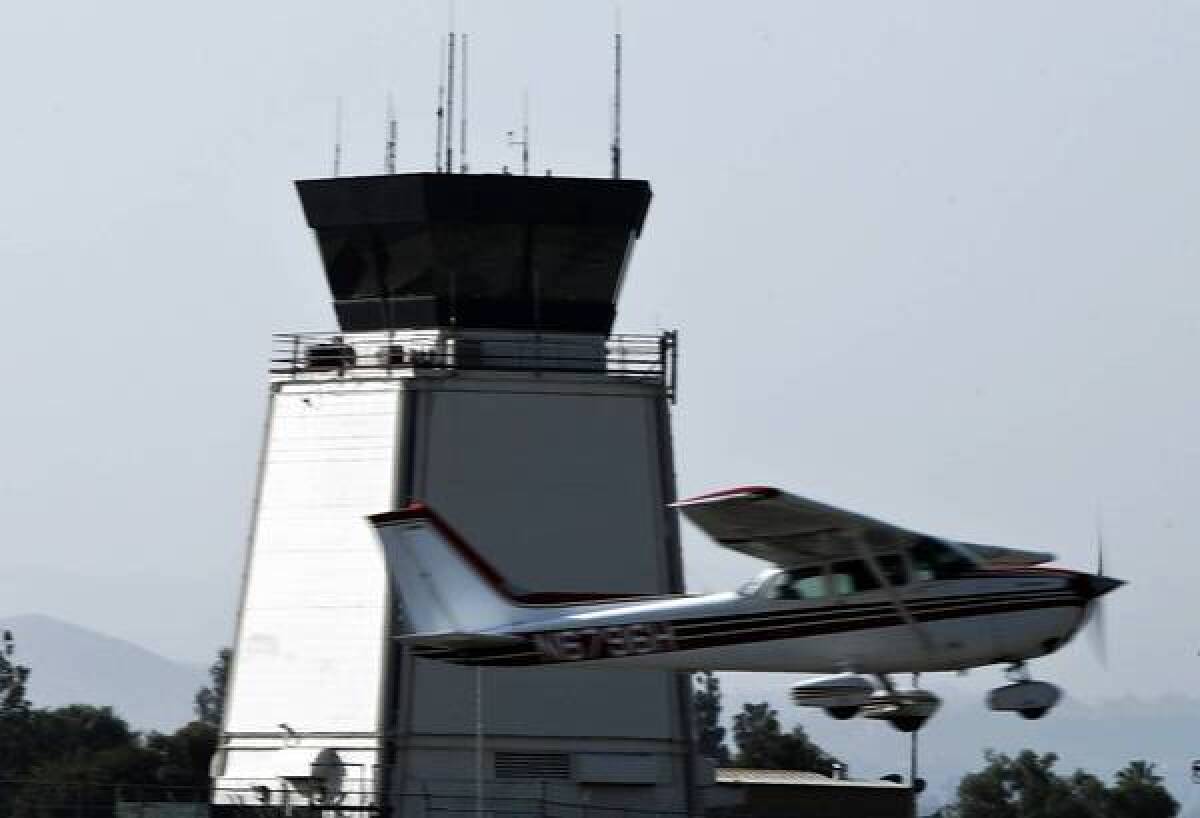14 Southern California air traffic control towers may close due to sequestration

Most days, about two dozen student pilots circle over downtown Riverside, taking cues on takeoffs, landings and the position of other planes from the air traffic controllers at the city airport.
âTheyâre an extra set of eyes on the runway,â flight instructor Jose Gonzalez said. âWhen youâre new, thatâs pretty important.â
But the guiding voices from the airport tower could go silent within weeks. The Federal Aviation Administration is expected to decide Friday whether to shut down as many as 238 air traffic control towers across the country, including 23 in California, as part of a plan to trim $600 million under the federal governmentâs forced spending cuts, known as sequestration. The towers would close April 7.
Southern California could lose 14 towers at airports in Palmdale, Pacoima, Victorville, Oxnard, Fullerton, Lancaster and elsewhere that handle civil, commercial and military flights. Also on the list is Santa Monica Airport, which will be considered in a later round of cuts.
Hundreds of airports across the nation have long operated without control towers, depending instead on communication between pilots over short-wave radios. But losing so many control towers in an airspace like Southern Californiaâs, which sees tens of millions of flights a year, increases the risk of collision in the air and on the ground, experts say.
âThe work of air traffic controllers is a very necessary layer of safety.â said Bob Spencer, a spokesman for the L.A. County Department of Public Works, which operates six of the regionâs airports. âThis is a densely populated area with heavily trafficked skies.â
The FAA is targeting towers at airports with less than 150,000 takeoffs and landings and less than 10,000 commercial flights a year. Those that donât serve âthe national interestâ will close, the FAA said in a letter to those facilities.
A majority of towers facing closure are FAA-certified but are operated by private contractors. Contract towers make up nearly half of the nationâs towers and handle about 30% of the air traffic.
Contract towers coordinate flights for corporate jets, military cargo planes and regional airlines. Some, including Lancasterâs General William J. Fox Airfield, house fleets of emergency response planes and helicopters that take off and land in rapid succession during disasters. Many coordinate with larger airports, such as Los Angeles International and John Wayne, so planes from different runways donât collide in shared airspace.
The FAA expects to save up to $50 million this year by closing contract towers, FAA Administrator Michael Huerta has told Congress. The agency accounts for just 20% of the Transportation Departmentâs budget but is being asked to absorb 60% of the cuts. Most of the agencyâs budget is exempt from the mandatory reductions.
Spencer Dickerson, head of the U.S. Contract Tower Assn., said lawmakers have made control towers the âposter child of sequestrationâ because airline safety is an emotional issue for many Americans. He said closing so many towers would jeopardize safety.
Huerta told Congress the FAA would not do anything that wasnât safe. But for uncontrolled airports to be as safe as airports with towers, they must run more slowly, he said â particularly when weather or visibility is bad and only one plane can land or take off at a time.
Efficiency matters most at times of crisis, said Spencer, the county public works spokesman. Whiteman Airport in Pacoima houses media helicopters that cover police chases, wildfires and manhunts. The U.S. Forest Serviceâs fleet of water tankers has used Fox Airfield for more than 40 years. When fires break out, dozens of helicopters take off within minutes.
The contract tower at Southern California Logistics, a 2,500-acre airport in Victorville, directs heavy military and commercial traffic. Boeing 747s being towed into maintenance sheds cross the same runway where more than 30,000 U.S. Army troops land each year.
âIt takes a long time for an aircraft to cross a runway,â airport manager Eric Ray said. âThereâs a lot more time for things to go south.â Losing their tower would be devastating to business because some companies will land only at airfields with towers.
Riverside Municipal helps its pilots navigate air traffic from March Air Reserve Base, which is 12 miles away. Four flight schools use the airportâs two intersecting runways, and a fifth is opening this fall.
Airport director Mark Ripley has run an uncontrolled airport in the past. Safety isnât impossible, he said. Itâs just much harder.
More to Read
Sign up for Essential California
The most important California stories and recommendations in your inbox every morning.
You may occasionally receive promotional content from the Los Angeles Times.











